What if a conspiracy theory turns out to be true? The return of the lab leak theory
Jun 14, 2021 —
On 26 May 2021 President Biden ordered the US intelligence agencies to deliver a report to him within 90 days, answering the question whether the coronavirus pandemic emerged naturally from animal-to-human transmission, or had leaked accidentally from the Wuhan Institute of Virology (WIV). The lab leak theory had been floated by President Trump and others in his circle in April last year. It was widely dismissed at the time as an unfounded conspiracy theory with racist undertones. A statement signed by prominent scientists in support of China in The Lancet in March 2020 cautioned against unfounded speculations about the origins of the virus, and an article in Nature found that SARS-CoV-2 did not have any obvious tell-tale traits of genetic engineering. It had seemed that the case was closed, but now the lab-leak-and-cover-up theory is back on the agenda. Various op eds in the last fortnight have wondered if the mainstream media was guilty of “groupthink” in failing to take the possibility seriously: “As we sift through the lab-leak debacle, the good news is that the healthy antibodies in the system are still strong enough to overcome the groupthink that produced the original error. News media are investigating a hypothesis they once dismissed, and the government has announced an investigation to find the truth” (Chait 2021). More worrying, Trump and his supporters have been quick to claim that they had been right all along, and should not have been dismissed as crazy conspiracy theorists. (Here it’s worth noting that what makes the lab leak story a conspiracy theory is that there is usually also the assumption that there must have been a cover-up on the part of the Chinese authorities, possibly in collusion with the WHO. Like Watergate, the real conspiracy was not original break-in—or in this case a break-out—but the subsequent scheming to cover it up.) Trump acolytes are also making the leap that if they were right about the lab leak theory, then they will be proved correct in their other assertions—for example that the 2020 election was stolen, or even that the whole QAnon narrative about a massive conspiracy of Satan-worshipping paedophiles is not a delusional fantasy after all.
If a conspiracy theory turns out to be true, are we still justified in calling it a conspiracy theory? The lab leak theory is a fascinating case study in its own right (and in this blog post we’re going to show how the story is more complicated than simply whether there was a conspiracy or not). But it also raises important questions about conspiracy theories in general, and how we should understand them as a social phenomenon: what counts as a conspiracy theory; the politics of using the label “conspiracy theory”; and the wider problem of distinguishing between legitimate scepticism and paranoid conspiracism.
Spotter’s guide to conspiracy theories
The definition of conspiracy theories usually goes something like this: they are “attempts to explain the ultimate causes of significant social and political events and circumstances with claims of secret plots by two or more powerful actors.” Although some researchers take an agnostic approach to whether a conspiracy theory is by definition false, often the default assumption is that the theory is unwarranted. In effect, the usual definition is that a conspiracy theory is merely an unfounded (or not yet proven) theory that a particular event is the result of a secret conspiracy. If experts (i.e. historians or scientists) come to the conclusion that the theory is in fact correct, then it is no longer called a conspiracy theory. Watergate is the usual example cited of a conspiracy theory that turned out to be true. A more recent and more complicated example is the case of Weapons of Mass Destruction in the lead-up to the Iraq war: those who were sceptical about the claim by the Bush and Blair governments that the Iraqi’s had the capability of launching a nuclear attack were dismissed at the time a conspiracy theorists. In contrast, few at the time accused Woodward and Bernstein of dabbling in conspiracy theory (the Washington Post came under fire from the Nixon administration itself, but not using the term “conspiracy theory”). One reason for this is that the very term “conspiracy theory” was only beginning to gain popular usage in the early 1970s, having emerged as a term of art in social science in the 1950s and 1960s, along with other discussions of the dangers of the “paranoid style” in American politics. As the historian Katharina Thalmann has shown, conspiracy theory as a recognisable way of making sense of the world began to be stigmatized as a pathology at the tail end of the 1950s, with the discrediting of McCarthyism as a mass delusion. The term “conspiracy theory” has thus tended to function as both a seemingly neutral description of a style of historical explanation, and an accusation that the proponent not only fundamentally misunderstands how history works, but is engaged aligned with harmful politics. On the one hand, the minimalist definition of a conspiracy theory as merely a theory of conspiracy fails to understand why they are a distinctive, problematic and seductive form of narrative explanation. On the other hand, the pathologising understanding of conspiracy theories tends to dismiss them as deluded, but it fails to see that they are not mere fantasies. As Mark Fenster puts it, “overarching conspiracy theories may be wrong or overly simplistic, but they may sometimes be on to something. Specifically, they may well address real structural inequities, albeit ideologically, and they may well constitute a response, albeit in a simplistic and decidedly unpragmatic form, to an unjust political order, a barren or dysfunctional civil society, and/or an exploitative economic system” (2008, 90).
In this project we are using the term “conspiracy theory” simply because it is one that most people recognise and understand, even if they are not always aware of its history and connotations. (And it’s therefore worth remembering that the term, as we understand it today, really only dates back to the philosopher Karl Popper’s work in the late 1940s, and that in some languages and cultures, especially in East Asia, there is no direct equivalent to the English term.) We always need to be aware that labelling a particular view as a conspiracy theory is not simply a neutral and objective act of classification. However, there is a cluster of identifiable characteristics that we can point to in terms of rhetorical style, argumentative assumptions, psychic investment and political functions that makes conspiracy theories distinctive (even if they are also closely related to other ways of making sense of the world, legitimate and otherwise).
It is a mistake to view conspiracy theories simply as a set of factual claims. Instead, they are more often seductive narratives that promise an overarching explanation for everything that happens. Conspiracy theories are not simply a theory that historical events are the result of secret plotting by evil agents, but they are a particular way of making sense of the world, which focuses on agency rather than structure. They usually insist that nothing is as it seems, nothing happens by accident, and everything is connected. They are often marked out by apocalyptic rhetoric and the demonisation of scapegoated Others. Conspiracy theorists tend to think of themselves as bravely going against received wisdom. Although believers in conspiracy theories tend to see themselves as are savvy and cynical, immune to the duplicity of the authorities and the mainstream media (unlike the rest of us “sheeple”), they are often oddly naïve in believing that there is a secret evil mastermind controlling everything. Conspiracy theories also marked out by their unfalsifiability and circular logic, their drive towards endless reinterpretation, and a surprising endless deferral of a final revelation and bringing the evil perpetrators to justice (except in films and novels, of course). If you try and debunk a conspiracy theory by pointing to the lack of credible supporting evidence, the conspiracy theorist will often claim that the lack of evidence is proof in itself: the conspiracy is so all-powerful, the argument goes, that they have managed to cover up any trace of their existence. If people in the media, government or science seem to have evidence that undermines the theory, then they must be shills for the conspiracy. In this way, conspiracy theories become ever more elaborate, relentlessly incorporating any conflicting evidence into an ever larger plot, even if the fundamental story arc is depressingly simplistic and repetitive.
Given this checklist, it therefore still makes sense to characterise something as a conspiracy theory, even if it turns out to be true. Moreover, we also need to think about the affective force of conspiracy belief. Conspiracy theories are not simply propositions that can be cast aside if new evidence comes to light, but instead are more usually part of a broader, deeply held worldview. We therefore need to think about the psychic investment that believers have in their theories: why do people hold onto beliefs, even when the evidence is speculative at best, and often contradictory at worst? Following Mark Andrejevic, we can turn to Slavoj Zizek’s discussion of a story told by Jacques Lacan about a pathologically jealous husband who, Zizek argues, should still be considered paranoid even if all his accusations turn out to be true. In many cases, the reason conspiracy theorists believe and cling to their beliefs is not warranted by the evidence (which would lead people to change their mind if new evidence comes to light), but by a near pathological commitment to the belief, fuelled by an intense need to blame and scapegoat. (We are not saying that this commitment is pathological in a literal clinical sense, because an affective attachment to beliefs driven by a sense of identity is something that many people share. However, it is also noticeable that some forms of conspiracy theory today are marked out by an infinite regress of suspicion, a free-fall of doubt in which nothing and no one can be trusted, even the seeming evidence for the theory itself. Increasingly conspiracy theories work in the mode of “as if”: current events look for all the world as if they had been planned, yet at the same time we doubt that is remotely possible in a world that is too complex and chaotic to manage.) Much conspiracism in the US and elsewhere today is fuelled by an understandable but often distorted sense of economic inequality and erosion of white male privilege. A populist resentment of elites, experts and authorities is then blamed on enemies both without and within. It is then coupled with a naïve fantasy that everything would be OK if only we could unmask and remove the villain—Bill Gates or George Soros—who had supposedly masterminded the plot. The system is never to blame, only a few bad apples.
“All of them combined is the reason the world is going the way it is” The lab leak theory was indeed one of the earliest and most popular conspiracy narratives to emerge. In the spring of 2020, polls showed that 17% of French people and 29% of Americans believed that the coronavirus was made intentionally in a laboratory.
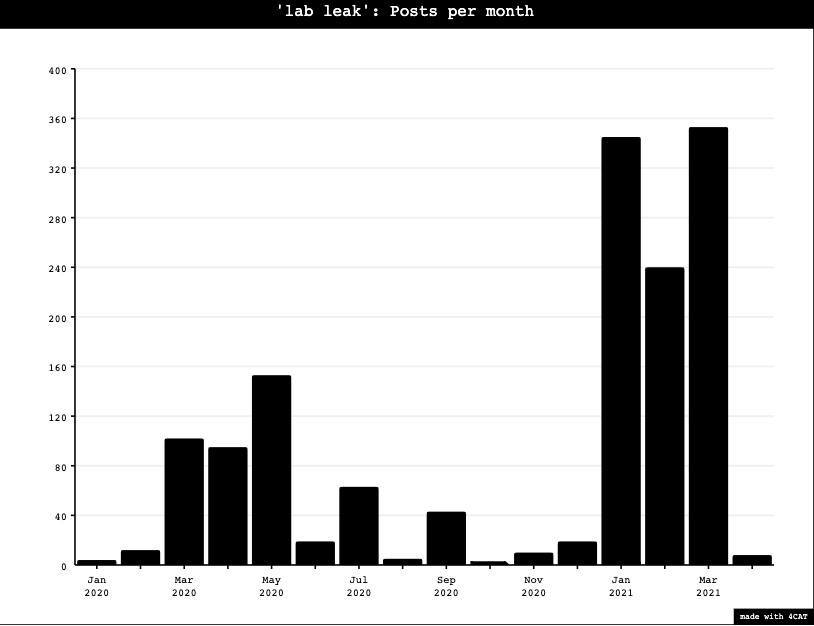
Fig.1: Twitter posts per month referencing the lab leak theory.
As a report from the BBC showed, last spring a video making this claim published by the Epoch Times, a site started by Chinese-Americans associated with Falun Gong, was viewed almost 70 million times on Facebook. It is based on the simple conviction that there are no coincidences: what are the chances of a new virus emerging organically in a market in Wuhan, when less than 4 miles away there is a Level 4 biosafety laboratory that had been working on bat coronaviruses? It’s true that in the early months of the pandemic last year, the media did not always clearly distinguish between a plausible hypothesis about an accidental leak from the WIV, and more far-fetched speculations the virus was deliberately created by the Chinese army as a bioweapon.
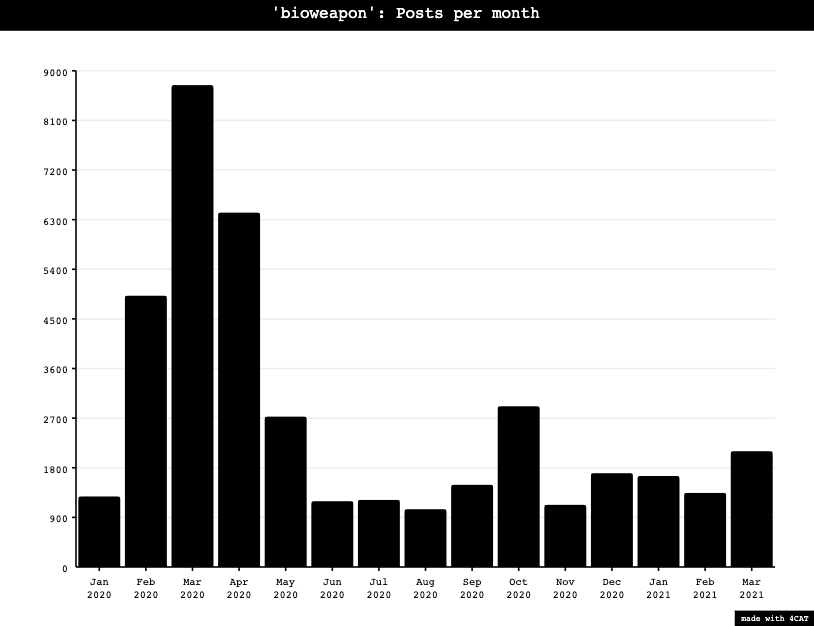
Fig.2: Twitter posts per month referencing the bioweapon theory. Note that in the spring of last year the number of posts per month is more than 30 times that of the lab leak theory on its own.
But on social media the lab leak theory very quickly became entangled with other—often contradictory—conspiracy theories. Right from the start, the lab leak theory was usually tied together with speculation that the virus had been manufactured as a bioweapon, usually by the Chinese, but in some mirror-image versions of the claim, by the Americans. In effect, on social media the lab leak theory is not one simple story, but comes in multiple different versions, sometimes in different combinations. In its simplest form, the claim is that there was an accidental leak or infection of staff by a naturally occurring sample that the WIV had been working on. There is also the claim that it was an accidental leak of a manipulated form of the virus: the suspicion was the WIV had been conducting genuine research on a particular coronavirus to see how to make a vaccine if needed, part of the larger project of so-called Gain of Function research, the aim of which is to tweak a naturally occurring animal virus to see how it might infect humans through zoonotic mutation and transmission, with the aim of then being better prepared to combat a future outbreak with vaccines. But then there is the theory that it was an accidental leak from secret research being carried out by the Chinese army at WIV into a bioweapon. And finally, some have claimed that it was a deliberate leak by the Chinese army of a bioweapon, against which the Chinese would somehow be immune. Most of these theories are also accompanied by the assumption that the Chinese government, possibly in collusion with the WHO, are involved in a conspiracy to cover things up. Q jumped on the bandwagon early on, mixing some sensible questions with wild speculation. The first post about the coronavirus from Q appeared on 23 March 2020, endorsing, in suggestive fragments at least, the conspiracy theory that COVID-19 is a bioweapon produced by China and the US Democrats in a plot to bring down Trump.
However, these lab leak theories are rarely propounded on its own. Often they involve a scattergun blast of different speculations, in endless combinations: both accidental and deliberate, both hoax and manufactured. Lab leak and bioweapon talk can branch off in many different directions.
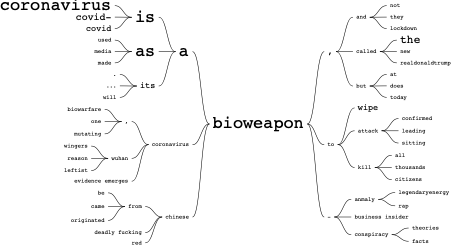
Fig.3: Word tree from our Twitter dataset
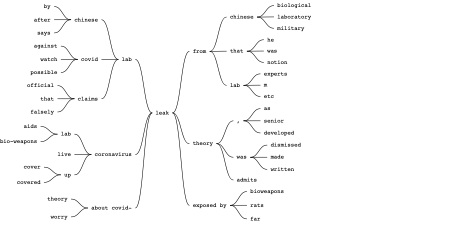
Fig.4: Word tree from our Twitter dataset
When we look at the way the lab leak story was discussed on social media, it was often connected to all kinds of other conspiracy speculations. This is a signature feature of the online conspiracy theory ecosystem during the pandemic (and is becoming the default mode of conspiracy theorising in general): conspiracy theories rarely come a single, separate claim, but are often integrated into endlessly shifting mega conspiracy theories that tie together all kinds of details and episodes into one overarching theory. While this theory suggests a vast, complex plot, often there is little detail. Conspiracy talk online is often gestural, hinting knowingly about a grand plan while providing little in the way of detail. For example, in a discussion of a video by the popular anti-vaxx figure Dr Shiva Ayyadurai, in the comments section there was the following exchange:
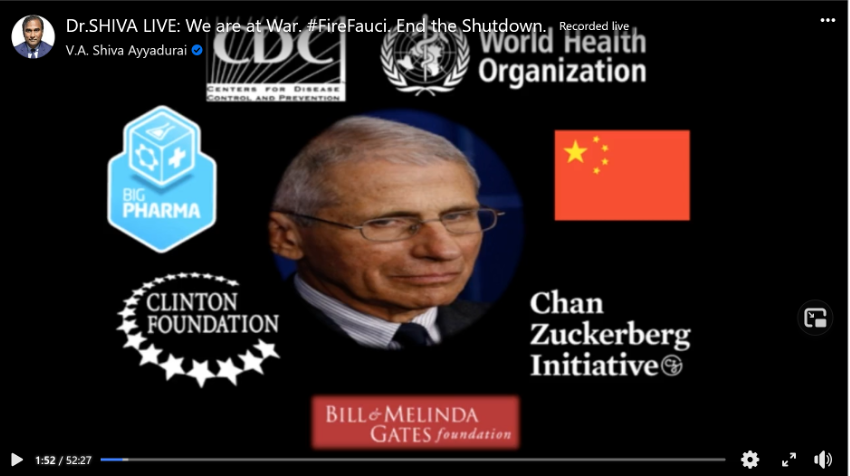

The turn to a gestural but all-encompassing conspiracism can in part by explained by the fact that the more complicated versions of the story (as told in lengthy, multi-part videos on YouTube or in long blog posts, websites and books) are often distilled down into a single meme. For example:

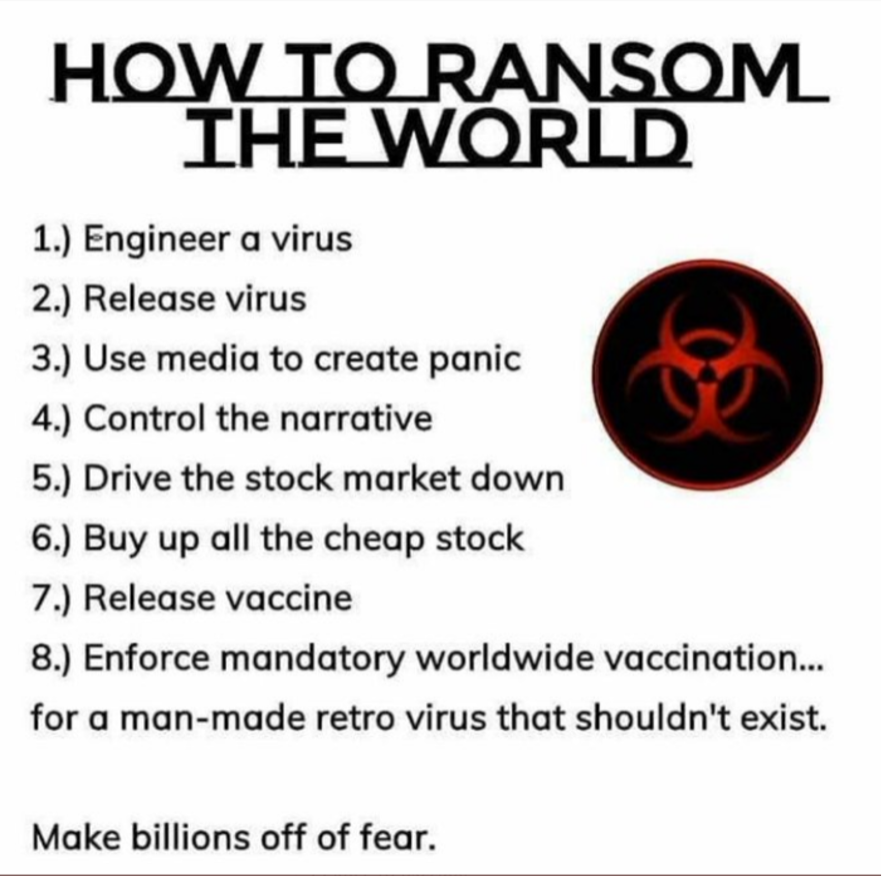


In many cases, the specific lab leak theory is quickly glossed over, as it becomes inserted into a far larger story that the pandemic was planned in advance by an all-powerful conspiracy, whose ultimate aim is to control the world through implanting chips in the vaccine, or to engage in mass depopulation. In effect, the idea of an accidental leak is replaced by the conviction that the release of the virus—perhaps made to look accidental—was part of an expertly orchestrated master plan for world domination (which often have antisemitic undertones).
On its own, the lab leak theory might be plausible. But the way it is discussed on social media last spring is often very much part of recognisable conspiracy culture, demonstrating many of the features of conspiracism we outline above. The characterisation of much of this online discussion as conspiracy theory remains true, even if the lab leak story is eventually confirmed. (However, it is important to note that we are unlikely to ever get final, definitive proof that would satisfy everyone. After all, conspiracy theorists are distrustful of all experts and authorities, so a definitive finding one way or the other by the US or Chinese government, or even by seemingly objective and neutral scientists, is unlikely to persuade them. And this is also true for those of us who are not committed conspiracy theorists: by now we have learned to be suspicious of supposedly authoritative findings by intelligence agencies, as we’ll discuss in more detail below.)
Don’t trust the messenger
So far, we’ve been considering what might be called organic or bottom-up conspiracy talk. But need to remember that conspiracy theories online are rarely entirely organic. As researchers have shown, they are often promoted by superspreaders, with President Trump the single largest driver of the spread of misinformation during the pandemic. There have also been campaigns of coordinated inauthentic behaviour, and other forms of disinformation and propaganda. As well as Trump, we need to consider the role of China and Russia. For example, early in the pandemic the US and China engaged in a tit-for-tat round of conspiracist insinuations about the origins of the virus, in connection with the lab leak and bioweapon stories. An official within China’s Ministry of Foreign Affairs, Lijian Zhao, speculated on Twitter: “It might be US army who brought the epidemic to Wuhan. Be transparent! Make public your data! US owe us an explanation!” In doing so, he endorsed a conspiracy theory that had been circulating on Chinese social media for weeks that 300 US athletes, attending the Military World Games in Wuhan, had brought COVID-19 to China. But theories of American culpability don’t only come from Chinese accusers. A report from EUvsDisinfo found that pro-Kremlin sources circulated fake news stories via YouTube videos in multiple languages that Covid-19 originated from secret American biolabs. This was a repeat of the Soviet and East German disinformation campaign in the early 1980s that seeded the conspiracy rumour that the US had created HIV/AIDS in a biowarfare lab.
It is therefore unwise to ignore the political context in which conspiracy theories emerge, and the vested interests they serve. The four people who promoted the theory most heavily were Trump, Republican Senator Tom Cotton, Trump’s former adviser Steve Bannon, and Tucker Carlson on Fox News. All have a track record of resorting to racism and conspiracy theory, often together. Trump, for example, had claimed that global warming is a hoax perpetrated by the Chinese to gain competitive advantage over the US, and his anti-China stance continued with his insistence on calling the coronavirus the “China virus” or the “Wuhan flu.” Before the outbreak had even been declared a pandemic by the WHO in March 2020, Bannon gave an interview to the billionaire exiled Chinese businessman Guo Wengui on his conspiracist G News, claiming that China had created the virus as a bioweapon theory. On Fox News, Tucker Carlson heavily promoted Li-Meng Yan, the quickly discredited scientist who made the whistleblowing claim that WIV was engaged in bioweapon research, and the coronavirus had been manufactured as part of that work.
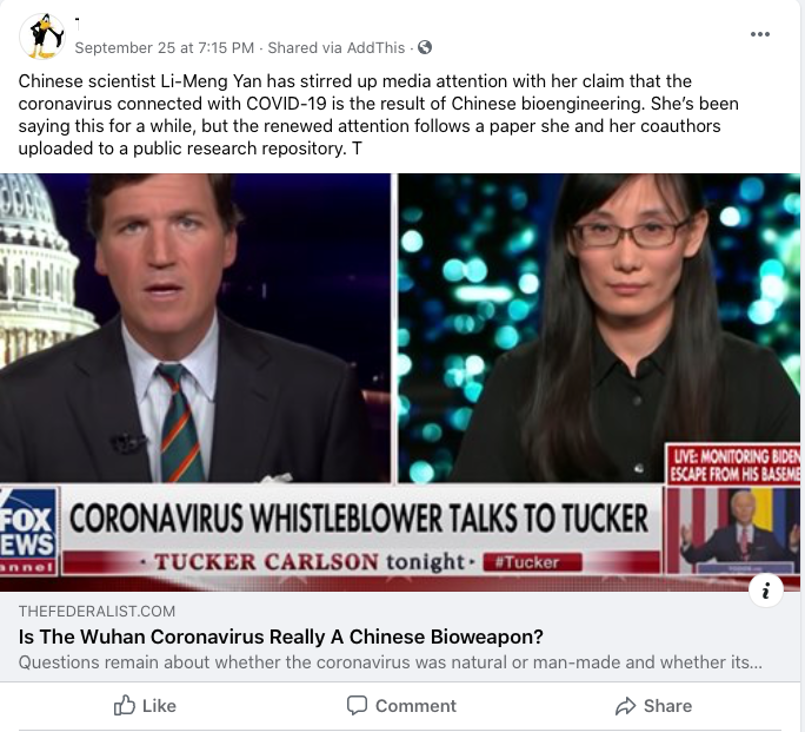
As the political scientists Nancy Rosenblum and Russell Muirhead have argued, the insinuation of a vast conspiracy, but without any evidence, is a favoured Trump move. At a press briefing on 30 April 2020, for example, Trump claimed that he had seen classified information indicating that the virus had come from the WIV. But when asked what the evidence was, he said, “I can’t tell you that. I’m not allowed to tell you that.” This is familiar Trump rhetoric. When in 2011 Trump pushed the Birther conspiracy theory (that President Obama was not US-born) he told an interviewer, “I have people that have been studying it and they cannot believe what they’re finding.” He was the president who cried wolf, and so it is understandable that the media and scientists were initially sceptical about the lab leak theory, suspecting that it might just be part of an anti-Chinese propaganda campaign, aimed to deflect attention away from failings in the US response to the pandemic.
Conspiracy, complicity and collusion
The current accusation from some critics of the liberal media in the US is that there is not much in the way of new revelations, so the return of the lab leak theory is merely a result of the shift from a bias against Trump to a bias in favour of Biden. However, there are three potentially significant new leads in the case. First, the Nobel prize-winning biologist David Baltimore was quoted in an article in May in the Bulletin of the Atomic Scientists (written by the controversial science writer Nicholas Wade) that the furin cleavage site of SARS-CoV-2 was a “smoking gun” that indicated that the virus was not solely a result of natural mutation. However, Baltimore has since walked back those comments, clarifying that analysis of the genome is compatible with both the natural origin and lab leak theories. (Other scientists with more direct expertise in coronaviruses, though, have pointed out that the lab leak theory is still very unlikely given the furin cleavage site and other features of the SARS-CoV-2 virus.)
Second, there are as yet uncorroborated intelligence reports of several lab workers at the WIV getting sick with coronavirus-like symptoms in November 2019. If true, this would be compelling evidence for the lab leak theory, given that it also strongly suggests that the institute itself, as well as the local and national Chinese authorities, were involved in covering up the story. However, we need to exercise some caution in accepting these intelligence reports on trust. The claim was included, for example, in an article in the Wall Street Journal, with the journalist briefed off the record by intelligence officials. The author of the piece – Michael R. Gordon – was the co-author of a notorious article in the New York Times in 2002 in the build-up to the Iraq war. That article had also relied on an off-the-record briefing from intelligence officials about the supposedly confirmed existence of Weapons of Mass Destruction, including the influential claim that the discovery of aluminium tubes in Iraq strongly suggested that Saddam’s regime had the capability of carrying out a nuclear attack. The much-quoted punchline of the article was that the first sign of a smoking gun would be a mushroom cloud. As we later discovered, the claim about WMD had been exaggerated, and the scaremongering line about the mushroom cloud had been fed to reporters by Vice President Dick Cheney. This is not to say that the new intelligence report about the lab staff in the WIV is wrong, but we need to make sure that we are not being played.
The third set of new revelations is about the way that the statement in The Lancet was put together, and the wider international scientific collaborations with WIV. In particular, as detailed in a lengthy article in Vanity Fair, we now know more (in part through the endeavours of DRASTIC, an online group of independent science researchers) about the role of Peter Daszak, head of EcoHealth Alliance, a scientific organisation which had channelled NIH grants for collaborations with WIV involving Gain of Function research on coronaviruses. Daszak had had not merely signed the statement in The Lancet, but had been pivotal in getting prominent scientists to add their names, all the while disguising his role. As the Vanity Fair article documents, there were many competing interests at work as various US intelligence agencies have investigated the lab leak claims, with some preferring “not to pursue an investigation into the origin of COVID-19” because it would “‘open a can of worms’ if it continued.” Gain of Function research in itself is nothing new or secret, but it raises complicated ethical issues that have previously received very little wider public discussion or scrutiny. As the Vanity Fair article explains: “With disreputable wing nuts on one side of them and scornful experts on the other, the DRASTIC researchers often felt as if they were on their own in the wilderness, working on the world’s most urgent mystery. They weren’t alone. But investigators inside the U.S. government asking similar questions were operating in an environment that was as politicized and hostile to open inquiry as any Twitter echo chamber. When Trump himself floated the lab-leak hypothesis last April, his divisiveness and lack of credibility made things more, not less, challenging for those seeking the truth.”
Obviously in terms of international politics it will be very significant if the lab leak theory turns out to be true. But even if it doesn’t (and there is still good reason to think that it won’t), focusing all our attention on conspiracy speculations means that we are in danger of missing other very important questions—not least about the safety and ethics of virus research around the world. The return of seemingly more warranted versions of the lab leak theory has also been accompanied by the kind of exaggerated speculation and grift that we see in other cases of major conspiracy theories. The 9/11 Truth Movement, for example, quickly attracted a raft of academic supporters who produced pseudo-scientific investigations into, say, the melting point of steel. In the case of the lab leak theory we see a similar trend, with a recent article in the Daily Mail featuring the work of two British scientists who asserted not only that they had found evidence that the coronavirus genome had been deliberately engineered but that their vaccine candidate (a Cinderella to the other vaccines already approved by health agencies around the world) was the only one that could be truly effective and safe because it had been designed to take into account the supposedly peculiar and unnatural features of the genome.
What the investigation into the lab leak hypothesis reveals is not really a tale of conspiracy (in the form of a cover-up), even if that turns out to be true. Instead it is a complicated story of competition, complicity and conflicts of interest. For the Trump administration China was presented as threat and a rival to American hegemony, but in the case of the WIV there was considerable cooperation in scientific research, even if the Chinese were less than transparent about all the activities taking place at the institute. One of the problems with conspiracy theory is that it means that we fail to consider forms of collective action that sit somewhere between the usual two poles of a conspiracy or a cock-up. And that is something that we find repeatedly in the world of conspiracy theories. In the case of the Kennedy assassination, for example, the Warren Commission report dismissed conspiracy theories, insisting that the shooting was the result of a lone gunman. However, what the report glossed over was the complex story of the Cold War, in which, for example, the US intelligence agencies—urged on by the Kennedy brothers—themselves had engaged in repeated illegal assassination attempts on Fidel Castro. If we insist on framing events simply in terms of conspiracy or no-conspiracy, we will fail to make sense of the more messy ways in which history – including global pandemics – unfold. The problem with conspiracy theories, and the way that they are instantly dismissed in public discussion, is that legitimate concerns get tarred with the brush of craziness. Often conspiracy theories seem to get close to asking the right questions, but their focus on trying to find a hidden masterplan behind everything that is happening distracts us not only from the more painstaking work of genuine investigative journalism, but from the more complicated analysis of our interconnected world, and the development of modes of political engagement that do not succumb to either naïve complacency or obsessive paranoia.
This post is published under the terms of the Attribution-NonCommercial-NoDerivatives 4.0 International (CC BY-NC-ND 4.0) licence.
